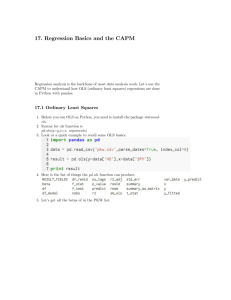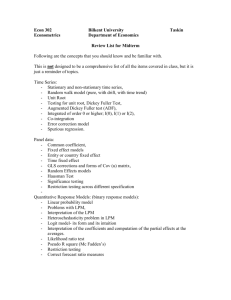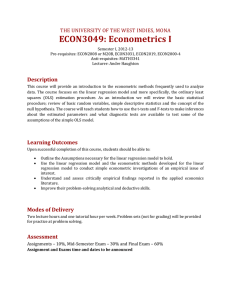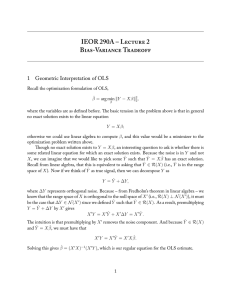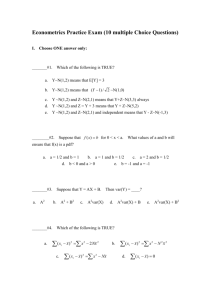Document 11143718
advertisement
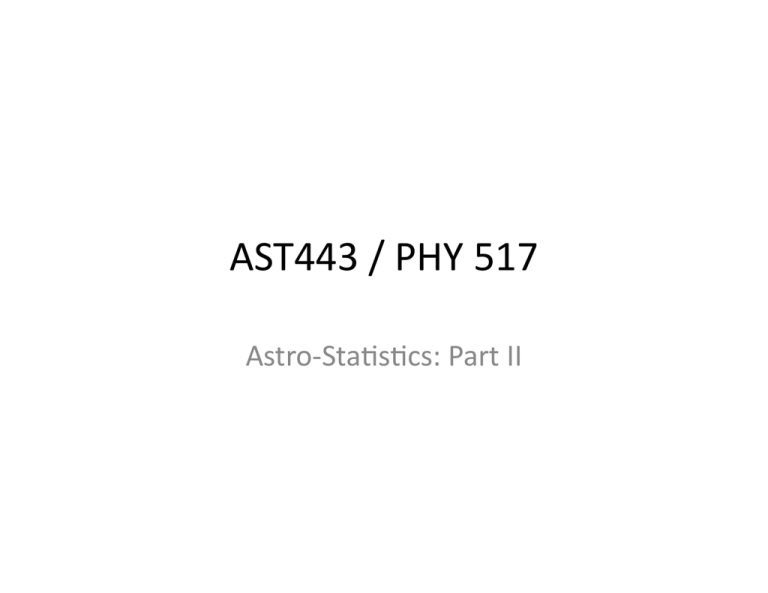
AST443 / PHY 517 Astro-­‐Sta4s4cs: Part II Some more advanced topics… • The C sta4s4c (TBD) • Smoothing • Linear Regression • Trunca4on and Censorship • Principle Component Analysis (TBD) Maximum Likelihood and the C sta3s3c Smoothing Data Real data are • oLen noisy. • oLen oversampled. In either case, it is some4mes advisable to smooth the data before analysis. At the very least, smoothing the data gives you a beQer idea of what is really in the data. Astronomical data are usually binned rather than con4nuous, that is, each event can be placed in a discrete bin. For example, – a photon detected by a CCD detector falls in a par4cular pixel on the detector, with integral values of X and Y coordinates – a flux is measured during a par4cular readout of the detector, which falls within a discrete 4me interval. Smoothing Data. II. • Coaddi3on. par4cularly useful when the data are oversampled. – Add together adjacent bins. – Add the errors in quadrature. This will decrease the number of pixels, increase the number of counts in each pixel, and improve the S/N in each pixel. Beware: if you coadd too many pixels you could lose resolu4on. • Running Mean, or Boxcar Smoothing. Replace each pixel by the mean of N pixels surrounding it. This does not decrease the number of pixels, but increases the S/N in each pixel by roughly a factor of √N. – Boxcar smoothing reduces the resolu4on. • Convolu3on The running mean is the convolu4on of the data with a step func4on of width N pixels. It is oLen advantageous, to smooth by convolving the data with other func4ons. – Convolve with a triangle or a Gaussian to place more weight on the central pixel, and beQer preserves the resolu4on (rela4ve to a boxcar), but the S/N is lower for the same width). – Convolu4on with fancier func4ons can be used for edge detec4on, or for detec4on of features of specified widths. Smoothing Data. III. Fourier Smoothing. Working in the frequency domain, you can preferen4ally filter out par4cular frequencies. • Real data are oLen affected by 1/f noise, or high frequency (pixel-­‐to-­‐pixel) noise. • Low frequency (slowly-­‐varying) noise does not greatly affect small features in an image (stars, or narrow spectral lines). Fourier smoothing works in the frequency domain by filtering the Fourier transform of the data. Remove the pixel-­‐to-­‐pixel noise by removing (zeroing-­‐out) all frequencies higher than the Nyquist (sampling) frequency). Since sharp edges in the transform lead to spurious features in the data, one generally mul4plies the Fourier transform of the data by a smoothly varying func4on that is unity at low frequency and zero at the highest frequency. The inverse transform of this product is the data with high frequency noise removed. The advantage of Fourier smoothing is that it removes high frequency noise while not affec4ng the resolu4on of the data (unless the bandbass of the filter is too narrow). Fourier filtering can also be used to select specific frequencies, or remove specific frequencies, from a data set. How to Fit Data In general, we use the technique of least-­‐squares or χ2 minimiza4on. In IDL, the following rou4nes are useful: • REGRESS does a least-­‐squares mul4ple linear regression. See the on-­‐line IDL help. • GAUSSFIT fits a gaussian line and a quadra4c background. See the on-­‐line IDL help. • POLY_FIT fits a polynomial to Y(X) and returns the coefficients. See the on-­‐
line IDL help. • CURVEFIT does a non-­‐linear least-­‐squares fit to a user-­‐supplied func4on with arbitrary parameters. See the on-­‐line IDL help. • MPFIT is a sophis4cated least-­‐squares fit4ng package for user-­‐supplied func4ons with arbitrary parameters and error bars. It lets one freeze or 4e parameters together. There is copious help available. Issues in Regression Analysis. I. References • Isobe, Feigelson, Akritas, & Babu. 1990, ApJ, 364, 104. • Feigelson, E.D. & Babu, G.J. 1992, ApJ, 397, 55. Linear regression analysis: what is the best linear rela4on between Y and X, Y(X). There are at least 5 different ways to do ordinary least squares (OLS) linear regression. So long as the linear correla4on coefficient |R| is less than unity, they generally give different answers. The only 4mes these 5 methods give iden4cal answers for Y(X) if |R|=1, or if |R| ≠ 1, the variances in X and Y are iden4cal, and the slope of the rela4on is unity. The methods are: • OLS(Y|X). Appropriate if all the errors are in Y. This minimizes the scaQer in Y. • OLS(X|Y). Appropriate if all the errors are in X. This minimizes the scaQer in X. • The Geometric mean, or bisector, of OLS(Y|X) and OLS(X|Y) • Orthogonal regression minimizes the ⊥ distance of the point from the fit. • Reduced major Axes (RMA), minimizes the X and Y devia4ons independently. Linear Regression: Ordinary Least Squares Given pairwise data (X,Y), where X is the independent variable, it is oLen useful to characterize Y as a func4on of X. The simplest way to do this is the ordinary least squares (OLS) fit, which minimizes the square of the devia4ons of the fit from the data points. In OLS(Y|X), Xi is fixed and Yi(Xi) are measured with some uncertainty σi. • Assume a func4onal form for Y, such as Y=aX+b The devia4on dy = Yi -­‐ Y(Xi) = Yi -­‐ b -­‐ aXi. The likelihood value is • Pi = 1/(σi sqrt(2π)) e-­‐(1/2 [(Yi -­‐ Y(Xi))/σi]2 Maximize the probability (likelihood) by minimizing the exponent (which is χ2), (Yi -­‐ b -­‐ aXi]/σi • Take the par4al deriva4ves with respect to the parameters a and b – d/db(χ2) = 0, d/da(χ2) = 0 • For a linear regression, this yields two linear equa4ons, – ∑Yi/σi = b ∑ (1/σi) + a ∑(Xi/σi) – ∑(XiYi)/σi = b ∑(Xi)/σi + a ∑(Xi)/σi Linear Regression: Ordinary Least Squares. II. In the simple case where σi = σ (a constant), and there are N points, solving the equa4ons gives • b = 1/D (∑Xi2∑Yi -­‐ ∑Xi∑XiYi) • a = 1/D (N ∑XiYi -­‐ ∑Xi∑Yi ) – where D = N ∑(Xi)2 -­‐ (∑Xi)2 • The uncertain4es in the parameters are • σa2 = 1/D ∑ 1/σi2 = 1/(N2σ2D) if all uncertain4es are the same. • σb2 = 1/D ∑ Xi2/σi2 = ∑ Xi2/(σ2D) if all uncertain4es are the same. • The deriva4on of the parameters for higher order fits is straightorward (but messier). The Linear Correla3on Coefficient The linear correla4on coefficient R is a measure of how well X and Y are correlated. For a linear model if y = a+bx, then x = a'+b'y If perfectly correlated, then b=1/b' and a=-­‐a'/b'. R = sqrt(bb') is a measure of the degree of correla4on. The sign is unimportant. A perfectly correlated sample will have |R|=1; an uncorrelated sample will have R=0 In terms of the parameters above, • R = (N ∑ XiYi -­‐ ∑Xi ∑Yi)/√([∑Xi2-­‐(∑Xi)2][∑Yi2-­‐(∑Yi)2]) The probability of equalling a value of |R| for ν = N-­‐2 degrees of freedom in an uncorrelated popula4on is • P(R;ν) = 1/√π Γ[(ν+1)/2]/ Γ(ν/2) (1-­‐R2)(ν-­‐2)/2 • The probability of exceeding R is 2∫|R|1 P(R;ν) dν • This func4on is tabulated in Table C.3 of Bevington and Robinson. Issues in Regression Analysis. II .What are the measured slopes for each method? Let: <x> = 1/N ∑xi <y> = 1/N ∑yi Sxx = ∑(xi -­‐ <x>)2 Syy = ∑(yi -­‐ <y>)2 Sxy = ∑(xi -­‐ <x>)(yi -­‐ <y>) β1 = Sxy/Sxx β2 = Syy/Sxy Then: Method Slope OLS(X|Y) β1 OLS(Y|X) β2 OLS bisector [β1+β2-­‐1 + √((1+β12)(1+β22))] / (β1 + β2) Orthogonal Regression 1/2 [(β2-­‐(β1)-­‐1) + sign(Sxy)√(4 + (β2-­‐
(β1)-­‐1)2) RMA sign(Sxy) √(β1β2) Issues in Regression Analysis. III OLS(Y|X) is generally the best choice if • the true rela4on is linear, • X is measured without error, • errors in Y have zero mean, finite variance, and are independent of all other points, and • errors in Y do not depend on X (this is oLen violated). Even if one or more of these assump4ons are violated, OLS(Y|X) can s4ll be used to predict Y(X). Feigelson & Babu (1992) discuss proper treatment of least-­‐squares regression in the presence of known errors. Issues in Regression Analysis. IV Isobe et al. ran a series of Monte Carlo simula4ons on data consis4ng of N points, with uncertain4es in both X and Y, and found the following: In the absence of any addi4onal knowledge, any rela4on can be used to predict Y(X). • Try fi~ng the data using all 5 techniques; if they agree within the errors there is no need to worry about what to use. • Orthogonal regression is considerably less accurate than the other methods. This works well only for log-­‐log or other scale-­‐free data. • OLS(X|Y) is unstable if |R| is small or if N is small. • All methods underes4mate the uncertain4es in the slopes when N is small. For R=0.5 and N=100, the uncertainty on the slope is underes4mated by 10%; for N=20 the uncertainty is underes4mated by 40%. • RMA should not be used. The slope is independent of R, and the technique cannot give any insights into the rela4on between X and Y. • If X is clearly causa4ve, use OLS(Y|X). • To predict Y from X, use OLS(Y|X). • To determine the func4onal form of Y(X) use the OLS bisector. Always quote the error in your derived slope! Trunca4on • Data are truncated if there is an ar4ficial upper or lower limit imposed. • An example is a magnitude-­‐limited survey. • Results can be biased • Trunca4on ≠ censorship – Trunca4on: existence is not established – Censorship: existence is known but value is limited Malmquist Bias • Malmquist bias occurs when the trunca4on is a func4on of the independent variable. • An example is a flux-­‐limited survey. • More distant objects must be more luminous than nearby objects to be observed with the same flux. Censored Data and Survival Analysis • Data that includes either upper or lower limits is called censored data. It is almost never appropriate to ignore limits and only fit the detected points -­‐ the only excep4on would be in the case of meaningless upper limits that lie far above all the other data points. • Type I censorship: limits known a priori (as in a flux-­‐limited survey) • Random censorship: limit independent of measurement References: • SchmiQ, J.H.M.M. 1985, ApJ, 293, 178. • Feigelson, E.D. & Nelson 1985, ApJ, 293, 192. Survival Analysis • Let L be a measurement (like a luminosity) • φ(L) is the probability density – φ(L’)dL’ is the probability that L lies between L’-­‐dL’ and L’+dL’ • Φ(L) = ∫L∞φ(l)dl is the cumula4ve distribu4on • In “normal” sta4s4cs: – the Hazard Func4on λ(L)=φ(L)/[1.-­‐Φ(L)] – This is the instantaneous rate of detec4on given L<l – Φ(L) = exp[-­‐(∫∞Lλ(l)dl)] The Kaplan-­‐Meier Product Limit Es4mator • Say that L can only be measured in the interval [A,C] • L<A⇒ upper limits (leL censoring) • L>C⇒ lower limits (right censoring) – In astronomy, usually C⇒∞, so L<A is the norm – In survival analysis, usually L>C • How do we determine the true popula4on in the presence of limits? The Kaplan-­‐Meier Es4mator. II. Ti is the measurement, randomly drawn from the distribu4on func4on φ(t) – Prob(T<t) • Assume random censorship • If Ti<Ai, the exact value of Ti is unknown • Record data pairs {xi, δi}, where – xi = Ti if Ti > Ai ; xi = Ai if Ti < Ai – δi = 1 if Ti > Ai ; δi = 0 if Ti < Ai The Kaplan-­‐Meier Es4mator. III. Most sta4s4cal treatments assume right censorship, so transform the variables: – Ti=M-­‐Ti – xi=M-­‐xi – Ci=M-­‐Ai – δi=δi where M is a constant ≥ the maximum of Ti Kaplan & Meier derived a parametric maximum-­‐likelihood es4mator Φ The survivor func3on S(t) = Prob(T≥t) = Prob(T>t) + Prob(T=t) S(t)=1-­‐Φ(t)+Prob(T=t) The Kaplan-­‐Meier Es4mator. IV. The Recipe Observe and rank n values of x, x1 < x2 < … <xn • x0 ≡ 0 Pi = Prob(T≥xi+1 | T≥xi) [a condi4onal probability] • For 1≤i≤j, S(xj) = Prob(T≥xj) =ΠPi where the product runs from i=0 to i=j-­‐1 How do you es4mate Pi? (i ≥ 1) • If xi is uncensored there are n-­‐i+1 true values xj≥xi. Pi=1-­‐[1/(n-­‐i+1)] • If xi is censored, all true values in the set xj ≥ xi are also ≥ xi+1. Pi=1 The Kaplan-­‐Meier Es4mator. IV. The Recipe. II. Generalizing: • Pi = [1 -­‐ 1/(n-­‐i+1)] δi • S(xj) = Π[1 -­‐ 1/(n-­‐i+1)] δi where the product runs from i=1 to j-­‐1 • S(t) is a non-­‐increasing step func4on that decreases only at uncensored points – nj = k where xk≥xj – dj = k where xk=xj The distribu4on func4on Φ of the true (uncensored) data is • Φ(t)=Prob(M-­‐T≤ t) = Prob(T≥M-­‐t) = S(M-­‐t) • S(t)=Π (1 – dj/nj) δi for t>x1 product runs over j for xj<t • S(t)=1 for t≤x1 The Kaplan-­‐Meier Es4mator. IV. The Recipe. III. • For large n, • S is distributed normally with mean S(t) • Variance σ2 = S(t)2 Σdjδj/nj(n-­‐1) Applicability of Survival Analysis • Not applicable in censoring is data-­‐dependent • Works poorly if data are highly censored (>90%) • Assumes the value Ai of the censored point is known. This is untrue in astronomy. Es4mates using 2 or 3σ upper limits give very different results. Principle Component Analysis
